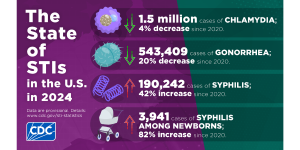
Latest Data Shows that Chlamydia, Gonorrhea, and Syphilis Rates are Dropping
The CDC just released STI Surveillance Data for 2024 that show cases of chlamydia, gonorrhea, and syphilis are slowly declining.

Chlamydia is a common and curable infection caused by the bacteria chlamydia trachomatis. It is the most common reportable STI in the U.S. In 2022, there were about 1.6 million cases reported.
Chlamydia can cured with antibiotic treatment, but if left untreated it can lead to complications such as pelvic inflammatory disease (PID) and, potentially, infertility. It can also can also cause a potentially fatal ectopic pregnancy (a pregnancy that occurs outside the uterus).
Very. As stated, chlamydia is the most common reported bacterial sexually transmitted infection (STI) in the U.S. It is most common in younger people—it is estimated that 1 in 20 sexually active young women aged 14-24 years has chlamydia.
Chlamydia is passed through oral, anal, or vaginal sex. Chlamydia can be passed from one person to another even if the penis or tongue does not go all the way into the vagina or anus. Eye infections can occur when discharge caries the disease into the eye during sex or hand-to-eye contact.
Chlamydia can also be passed from mother to newborn as the baby passes through the infected birth canal. This can result in eye infections, pneumonia or other complications.
It is important to understand that focusing on signs and symptoms is not very useful in determining if someone is infected with chlamydia. First, the symptoms of chlamydia are similar to the symptoms of gonorrhea, and the two infections are often confused. Also most women and about half of men don’t have any symptoms. So, most people who are infected will not be able to tell from symptoms.
If a person does have symptoms, they usually develop within one to three weeks after exposure to chlamydia. How long a person remains infectious (able to transmit the bacteria to others) is difficult to determine since so many people are asymptomatic (have no symptoms). A person must be considered infectious from the time they become infected until treatment is completed.
If a person does have symptoms, they may include:
If the infection spreads to the fallopian tubes, symptoms may include:
Learn more about these two common—and curable—infections in this printable fact sheet. It covers the many things these two STIs have in common and includes information on testing, treatment, and staying healthy.
Because chlamydia is very common and so often has no symptoms, anyone who is sexually active should think about being tested. Because chlamydia is very common among young women, the Centers for Disease Control and Prevention (CDC) recommend sexually active women age 25 or younger get tested once per year. Chlamydia testing is also recommended for women with new or multiple sexual partners and pregnant women.
Anyone who is sexually active should talk with a healthcare provider about whether they need testing for chlamydia or other STIs. Don’t be afraid to speak openly about your sex life, as you can get the best care by having an honest discussion with your health care provider.
There are several different reliable tests for chlamydia. Newer tests, called NAATs (short for nucleic acid amplification tests), are very accurate and easy to take. Your health care provider can explain what testing options are available (urine or swab tests, for example). If you don’t have a regular healthcare provider, you can search here for a clinic near you.
People infected with chlamydia are often also infected with gonorrhea, so patients with chlamydia are often treated for gonorrhea at the same time, since the cost of treatment is generally less than the cost of testing.
If you live in Alaska, Maryland, or Washington, D.C., you can have a free at-home chlamydia test. Visit iwantthekit.org for more information.
There are antibiotic treatments that are effective in treating chlamydia. A health care provider will decide which antibiotic is prescribed, taking into consideration the particular needs of the patient.
Whatever treatment is prescribed, there are some important points about any treatment:
Chlamydia can be treated and cured easily, but that doesn’t mean that chlamydia infection isn’t potentially dangerous. If chlamydia isn’t diagnosed and left untreated, it can cause serious complications.
Untreated chlamydia infections in women may lead to:
Untreated chlamydia in men may lead to:

The CDC just released STI Surveillance Data for 2024 that show cases of chlamydia, gonorrhea, and syphilis are slowly declining.

On a recent episode of Love Island, a cast member sugested that we could blame our current STI epidemic on men who had sex with animals. She pointed to koalas with chlamydia as an example. There’s some truth here, but also a lot of misinformation.

Many people who take doxy PEP say it gives them peace of mind in their relationships and sex life. We sat down with Oscar Alexis, Efthimios, and Maxfield Haynes to talk about doxy PEP and get their perspective.

About 1.6 million cases of chlamydia and 600,000 cases of gonorrhea are diagnosed in the United Sates each year. A new study suggests that these patients may not be following through with STI treatment or getting the right antibiotics.

The FDA just approved a new, fully at-home test for chlamydia, gonorrhea, and trichomoniasis. The tests, which is only for women, will be available without a prescription. Users can collect their own sample and have results in less than 30 minutes.

A new study found that there are two distinct types of BV infection, one of which increases the risk of chlamydia infection.

Two studies published in this month’s JAMA Internal Medicine offer encouraging findings about the use of Doxy PEP.

Nongonococcal urethritis—or NGU—is an infection of the urethra caused by germs other than gonorrhea. The most common cause is chlamydia.
ASHA believes that all people have the right to the information and services that will help them to have optimum sexual health. We envision a time when stigma is no longer associated with sexual health and our nation is united in its belief that sexuality is a normal, healthy, and positive aspect of human life.
ABOUT
GET INVOLVED
ASHA WEBSITES
GET HELP
© 2025 American Sexual Health Association